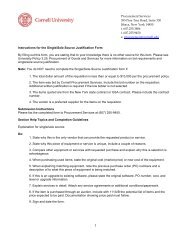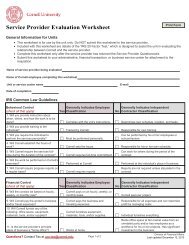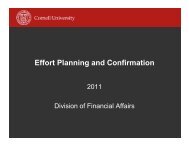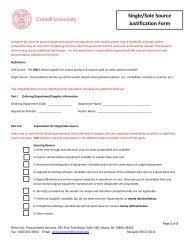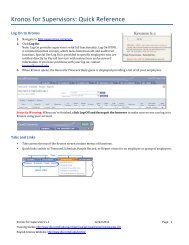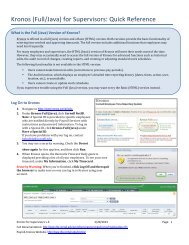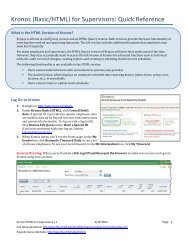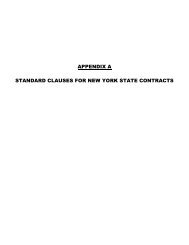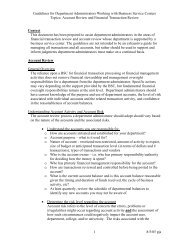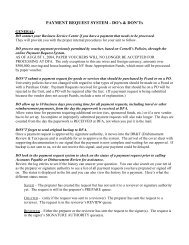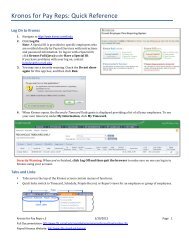Cornell University 2011-2012 Annual Report - DFA Home - Cornell ...
Cornell University 2011-2012 Annual Report - DFA Home - Cornell ...
Cornell University 2011-2012 Annual Report - DFA Home - Cornell ...
Create successful ePaper yourself
Turn your PDF publications into a flip-book with our unique Google optimized e-Paper software.
The increase in accounts receivable is best understood byreviewing the key components as disclosed in Note 2 of theconsolidated financial statements. The decline in grant andcontract receivables occurred at both campuses, though fordifferent reasons. The decline in the receivable at the Ithacacampus is based on extensive effort undertaken by the<strong>University</strong>, including its government affairs office, to workwith key agencies in New York State to expedite paymentson longstanding receivables; this resulted in an overall $9.5million decline in our New York State receivable balance.The Medical College, in this fiscal year, continued its ongoingreview of old receivables. This resulted in a $19.7million write-off of grant receivables and an $18.1 millionwrite-off of the New York Hospital receivable. Of the totalwrite-offs, $28.1 million was written off against the previouslyestablished allowance account and had no impact oncurrent-year expenses. Additionally, the Medical Collegehas established procedures to help ensure timely collectionsof all receivables. The New York Hospital and the MedicalCollege now meet their respective obligations for sharedservices within ninety days, based on actual payments. Thesignificant decrease in the allowance for doubtful accounts atJune 30, <strong>2012</strong> is based primarily on the write-offs describedabove for the Medical College.At fiscal year ending June 30, <strong>2012</strong>, there was no collateralon deposit with third parties for the debt swap agreements.Based on the revised collateral terms, collateral is no longerrequired for fair market value adjustments, but only requiredif the <strong>University</strong>’s credit rating falls below an “A” rating. Asof June 30, <strong>2012</strong>, the <strong>University</strong> continues to maintain itsstrong credit rating: Aa1 (Moody’s) and AA (S&P).The re-insurance receivable was recorded in the current yearbased on the requirements of the ASU. In prior years, the<strong>University</strong> was permitted to net the malpractice re-insurancereceivable against the liability as previously discussed.The increase of $279.0 million, or 47.7 percent, in contributionsreceivable is commensurate with the overall increasein operating and non-operating contribution revenue.Contribution revenue generally increases more significantlythan the receivable because many contributions are cashnot pledges.The decline in the fair market value of <strong>University</strong> assets isbased primarily on unrealized losses from the fair marketvalue adjustments at the end of this fiscal year. Fair marketvalue adjustments, as the financial press reminds us, areoften related to the asset allocations in the portfolio withsome sectors outperforming others.Building at the Medical College, and numerous projectsfor the contract colleges: Martha Van Rensselear East WingRehabilitation, and Stocking, Rice, Morrison, and WarrenHalls. Many of these new buildings will seek “Leadership inEnergy and Environmental Design” (LEED) certification.The <strong>University</strong>’s record for LEED certification is exceedinglyimpressive: LEED Platinum certification for the HumanEcology Building and LEED Gold certification for at leasteight other completed projects including Milstein Hall, NYSVeterinary Diagnostic Lab, and others.The most significant increase in liabilities in fiscal year endingJune 30, <strong>2012</strong> is the $256.2 million increase in accountspayable and accrued expenses, a 69.8 percent increase. Theincrease is primarily due to $166.5 million increase in thefair market value for debt swaps and the recording of $70.2million in insurance claims required by ASU 2010-24.The bonds and notes payable decline reflects $35.6 millionin principal payments and no new debt in fiscal year <strong>2012</strong>.SummaryAs we review fiscal year <strong>2012</strong>, we note that the <strong>University</strong>’sfinancial picture is strong with $7.5 billion in net assets andoperating income of $46.8 million.We are all mindful that the economy has not regained itspre-2008 strength. This impacts almost all organizations,but the impact on research universities is primarily inheightened demand for student financial aid, heightenedcompetition for sponsored support, particularly from thefederal and state governments and additional uncertaintyabout endowment performance and endowment payout.The <strong>University</strong>’s financial strength, as this year clearly demonstrates,is greatly enhanced by the generosity of donors,whether for buildings, endowments, or operations. Manycritical activities simply could not be accomplished withoutthis commitment and generosity of alumni and friends ofthe <strong>University</strong>.Anne Shapiro<strong>University</strong> ControllerThe <strong>University</strong> continues to enhance its physical plant withnew buildings, improvements to older buildings, and infrastructureprojects. The 5.6 percent increase in fiscal year<strong>2012</strong> consists of projects placed in service as well as thosein construction in progress (CIP). CIP at fiscal year-endconsists principally of Olin Library Improvements, GatesHall, Clark Hall Renovation, the Belfer Medical Research6



